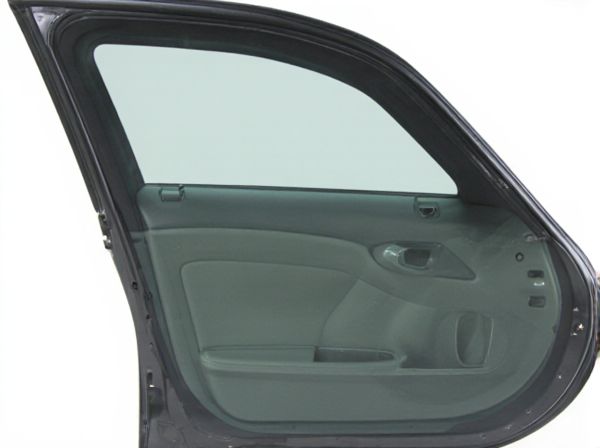
Photo illustration: Laminated Glass Door vs Tempered Glass Door
A laminated glass door offers enhanced safety by holding shards together if broken, making it ideal for areas requiring added security and noise reduction. Tempered glass doors provide superior strength and shatter into small, less harmful pieces, suitable for high-impact environments. Your choice depends on whether safety or durability is your top priority.
Table of Comparison
| Feature | Laminated Glass Door | Tempered Glass Door |
|---|---|---|
| Safety | Shards remain bonded to plastic layer, reducing injury risk | Shatters into small, blunt pieces to prevent cuts |
| Durability | Strong impact resistance, less prone to breakage | High strength; stronger than laminated but prone to sudden breakage |
| Sound Insulation | Excellent noise reduction due to plastic interlayer | Moderate sound insulation |
| UV Protection | Blocks up to 99% UV rays | Limited UV blocking capability |
| Cost | Higher price due to layered construction | Generally more affordable |
| Visibility | Clear with minimal distortion | Clear and distortion-free |
Introduction to Laminated and Tempered Glass Doors
Laminated glass doors consist of two or more glass layers bonded with an interlayer, providing enhanced safety by holding shards together upon breakage. Tempered glass doors undergo heat treatment to increase strength, shattering into small, blunt pieces to reduce injury risk. Both types improve durability and security, but laminated glass offers superior impact resistance and sound insulation compared to tempered glass.
What is Laminated Glass?
Laminated glass is a type of safety glass composed of two or more layers of glass bonded together with an interlayer, usually made of polyvinyl butyral (PVB), which holds the layers firmly in place even when shattered. This structure enhances security and sound insulation, making laminated glass ideal for doors requiring impact resistance and added protection against break-ins. Unlike tempered glass, laminated glass remains intact when broken, minimizing the risk of injury from sharp shards.
What is Tempered Glass?
Tempered glass is a type of safety glass processed by controlled thermal or chemical treatments to increase its strength compared to normal glass. It shatters into small, blunt pieces when broken, reducing the risk of injury. Commonly used in doors, windows, and automotive applications, tempered glass offers enhanced durability and impact resistance over standard glass.
Strength and Durability Comparison
Laminated glass doors feature multiple layers of glass bonded with a polymer interlayer, providing enhanced impact resistance and preventing shattering upon breakage, making them ideal for high-security environments. Tempered glass doors undergo a heat treatment process, increasing their strength by up to four times compared to regular glass, and break into small, less harmful pieces, offering superior durability under everyday stress and temperature changes. While tempered glass excels in resistance to thermal and mechanical stress, laminated glass provides better safety and structural integrity due to its ability to hold fragments together after impact.
Safety Features: Laminated vs Tempered Glass
Laminated glass doors offer superior safety due to their multi-layered structure, where a plastic interlayer holds shards together upon impact, reducing the risk of injury. Tempered glass doors, while stronger than standard glass and designed to shatter into small blunt pieces, do not provide the same containment as laminated glass. The choice between laminated and tempered glass doors significantly impacts safety, with laminated glass being the preferred option in environments requiring enhanced protection against breakage and intrusion.
Sound Insulation Capabilities
Laminated glass doors offer superior sound insulation due to their interlayer, which effectively dampens noise transmission compared to tempered glass doors. The polyvinyl butyral (PVB) layer in laminated glass reduces sound vibrations, making it ideal for environments requiring enhanced acoustic privacy. Tempered glass doors, while strong and impact-resistant, provide less noise reduction, making laminated options preferable for sound-sensitive spaces.
Cost Differences Between Laminated and Tempered Glass Doors
Laminated glass doors generally cost more than tempered glass doors due to the additional manufacturing process involving multiple glass layers bonded with a plastic interlayer. The plastic interlayer in laminated glass enhances safety and sound insulation, which justifies the higher price despite the comparable thickness and strength of tempered glass. Installation and maintenance costs remain similar, but the superior durability and security features of laminated glass often result in better long-term value despite the initial higher investment.
Applications and Ideal Usage
Laminated glass doors provide superior safety and sound insulation, making them ideal for commercial buildings, schools, and residential use where impact resistance and security are priorities. Tempered glass doors are best suited for high-traffic areas such as storefronts, offices, and bathrooms due to their strength and shatter-resistant properties under thermal and mechanical stress. Selecting laminated glass enhances protection against forced entry and noise, while tempered glass offers durability and safety in environments prone to sudden impact and temperature changes.
Aesthetic Options and Customization
Laminated glass doors offer extensive aesthetic options with the ability to incorporate decorative interlayers such as tinted, patterned, or colored films, providing versatile customization for unique design preferences. Tempered glass doors emphasize sleek, minimalist looks with smooth, clear surfaces and limited color variations, ideal for modern, clean-lined aesthetics. Both options support custom sizes and finishes, but laminated glass excels in personalized artistic expression due to its layered construction.
Choosing the Right Glass Door for Your Needs
Laminated glass doors offer superior safety and sound insulation by holding shards together when broken, making them ideal for high-traffic or security-sensitive areas. Tempered glass doors provide enhanced strength and resistance to impact and thermal stress, suitable for environments requiring durability and safety under heavy use. Selecting the right glass door depends on factors like safety requirements, noise control, and exposure to potential impacts, ensuring optimal performance and protection.
 caratoz.com
caratoz.com